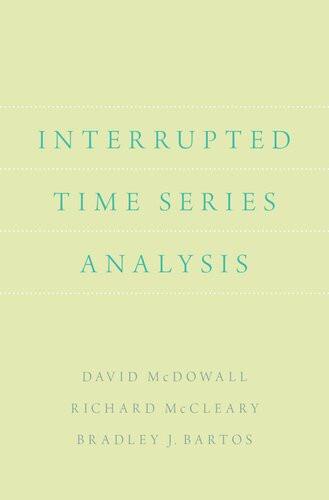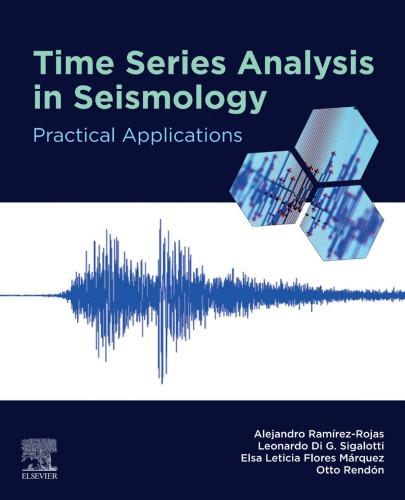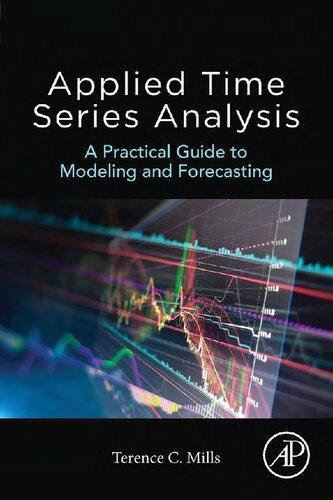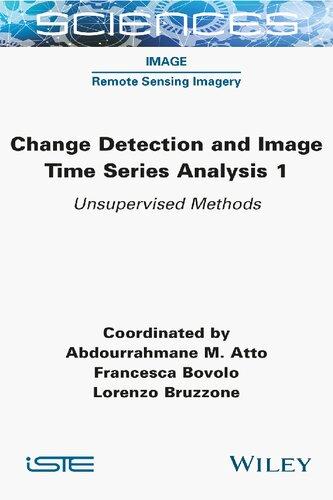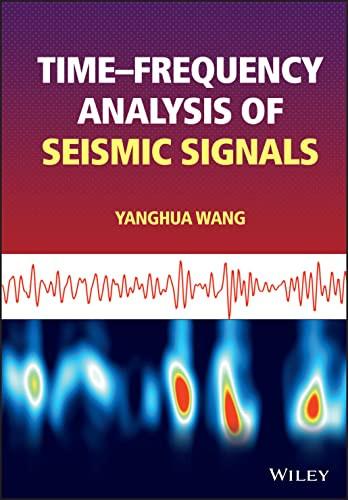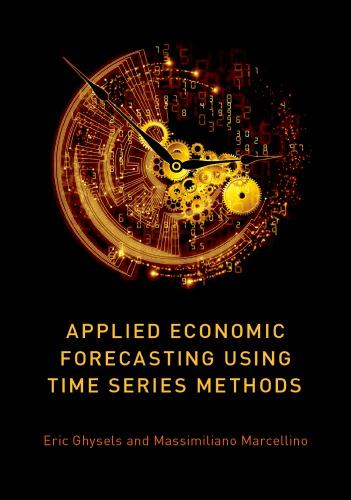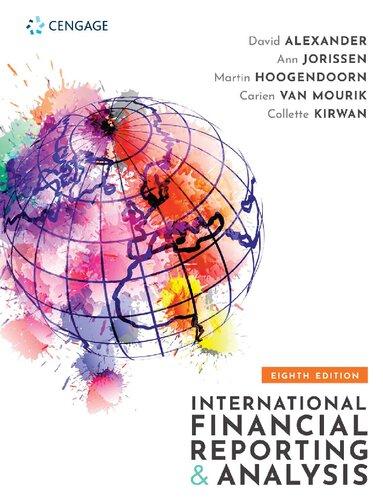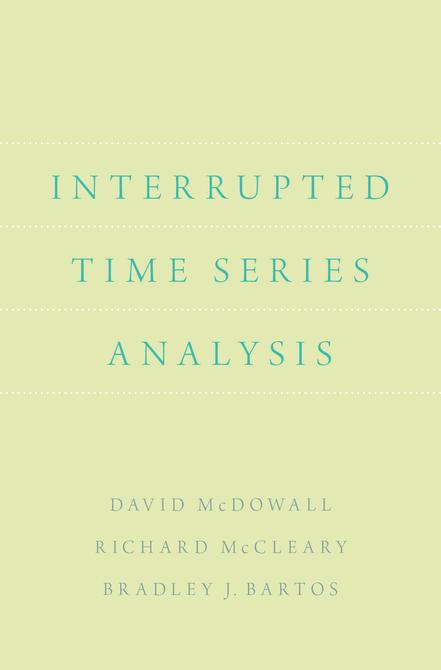Interrupted Time Series Analysis David Mcdowall Visit to download the full and correct content document: https://ebookmass.com/product/interrupted-time-series-analysis-david-mcdowall/
More products digital (pdf, epub, mobi) instant download maybe you interests ...
Time Series Analysis in Seismology: Practical Applications 1st Edition Alejandro Ramírez-Rojas
https://ebookmass.com/product/time-series-analysis-in-seismologypractical-applications-1st-edition-alejandro-ramirez-rojas/
Applied Time Series Analysis. A Practical Guide to Modeling and Forecasting Terence C. Mills
https://ebookmass.com/product/applied-time-series-analysis-apractical-guide-to-modeling-and-forecasting-terence-c-mills/
Change Detection and Image Time Series Analysis 1: Unsupervised Methods 1st Edition Abdourrahmane M. Atto
https://ebookmass.com/product/change-detection-and-image-timeseries-analysis-1-unsupervised-methods-1st-edition-abdourrahmanem-atto/
Same Time, Same Place David M. Barnett
https://ebookmass.com/product/same-time-same-place-david-mbarnett/
Time-frequency Analysis of Seismic Signals Yanghua Wang https://ebookmass.com/product/time-frequency-analysis-of-seismicsignals-yanghua-wang/
Time Villains Series, Book 1 Victor Piñeiro https://ebookmass.com/product/time-villains-series-book-1-victorpineiro/
Applied economic forecasting using time series methods Ghysels https://ebookmass.com/product/applied-economic-forecasting-usingtime-series-methods-ghysels/
Same Time, Same Place: A Novel David M. Barnett https://ebookmass.com/product/same-time-same-place-a-novel-davidm-barnett/
International Financial Report Analysis 8th Edition
David Alexander
https://ebookmass.com/product/international-financial-reportanalysis-8th-edition-david-alexander/
AdvancePraisefor InterruptedTimeSeriesAnalysis “InterruptedTimeSeriesprovidesexcellentopportunitiesforsubstantiveanalysesofexperimentalinterventionstoaddressfundamentalquestionsinthesocial sciences.Thisbookprovidesupdatedexpositionsofrelatedstatisticalissuesof design,estimation,andinterpretationofsuchinterruptions.Itwillbeofgreat valuebothforclassroomuseandforindividualresearchers.”
—KennethLand, JohnFranklinCrowellProfessorEmeritusofSociology,DukeUniversity
“ITSA,theidealvademecumfor DATSE.”
—GeneV.Glass,SeniorResearcher,NationalEducationPolicyCenter, UniversityofColoradoRegents’ProfessorEmeritus, ArizonaStateUniversity
“WhenDrs.McCleary,McDowall,andBartosdevelopedtheirinnovative DesignandAnalysisofTimeSeriesExperiments(DATSE) bookin2017,they alsoproducedanimportantcompaniontext, InterruptedTimeSeriesAnalysis (ITSA).TheITSAvolumeprovidesresearcherswithaverycomprehensivesetof analytictoolsfordrawingcausalinferencesfromtime-seriesexperiments.ITSA isnotonlyavalue-addedwork,butacriticaladditiontoresearchersinterested intime-seriesmethodologyandoptionalmethodsofdataanalysis.Ihighly recommendittoresearchersinterestedintime-seriesresearchincludingthose involvedinsingle-casemethodology.Theseworkswillbeclassics.”
—ThomasR.Kratochwill,Sears-BascomProfessorofEducation, UniversityofWisconsin-Madison
“Thisbookcombatstheperceptionthatlookingatthedatabeforehandis ‘cheating,’thatthebestwaytodealwithdataistorunitblindlythrougha statisticalmincingmachine(likeoneofthefourS’s—SAS,SPSS,Stata,Systat) andlookforasufficientlylowp-value.Itshowsthebenefitofunderstandingthe data’scharacteristicsbeforehand.”
—MichaelD.Maltz, ProfessorEmeritusofCriminalJusticeandof InformationandDecisionSciences,UniversityofIllinoisatChicago AdjunctProfessorofSociology,OhioStateUniversity
“ITSApresentsanexcellentexpositionofideasnotjustabouttimeseries,but interruptedtimeseries,whichiswhatmostsocialscientistsandpolicyanalysts needtoknow.Thereisathoroughdiscussionoftypesofeffects:permanent vstemporary,suddenvsgradual;thesedichotomiesarecrucialtotheaccurate characterizationofeffects.Oneissuethatseparatestheapproachherefromthe usualtime-seriesmodelsisthatRubin’scausalmodel(RCM)isintegratedinto adiscussionofwhetherandwhencausalityinferencesarewarranted.RCM leadstodevelopmentofasyntheticcounterfactualcontroltimeseries,another innovationnotdiscussedinmanyplaces.Thiswouldbeanexcellenttextfor aone-semestercourseonusingtimeseriestoinvestigatetheeffectsofpolicy changesonthebehaviorofindividualsandorganizations.”
—DavidRindskopf,DistinguishedProfessor,CUNYGraduateCenter
“McDowall,McCleary,andBartosprovideaconciseandaccessibleintroductiontotheuseofARIMAmodelsforanalyzinginterruptedtime-series quasi-experiments.Thispracticalguidewillbeofgreathelptoappliedanalystsin publicpolicyevaluation,economics,epidemiology,publichealth,andeducation research.Includeschaptersonrecentadvancestothemethod,suchastheuseof syntheticcontrols.”
—AlexanderC.Wagenaar,ProfessorEmeritus,UniversityofFlorida CollegeofMedicineResearchProfessor,EmoryUniversityRollinsSchool ofPublicHealth
InterruptedTimeSeriesAnalysis InterruptedTimeSeries Analysis DAVIDMcDOWALL RICHARDMcCLEARY BRADLEYJ.BARTOS OxfordUniversityPressisadepartmentoftheUniversityofOxford.Itfurthers theUniversity’sobjectiveofexcellenceinresearch,scholarship,andeducation bypublishingworldwide.OxfordisaregisteredtrademarkofOxfordUniversity PressintheUKandcertainothercountries.
PublishedintheUnitedStatesofAmericabyOxfordUniversityPress 198MadisonAvenue,NewYork,NY10016,UnitedStatesofAmerica.
©OxfordUniversityPress2019
Allrightsreserved.Nopartofthispublicationmaybereproduced,storedin aretrievalsystem,ortransmitted,inanyformorbyanymeans,withoutthe priorpermissioninwritingofOxfordUniversityPress,orasexpresslypermitted bylaw,bylicense,orundertermsagreedwiththeappropriatereproduction rightsorganization.Inquiriesconcerningreproductionoutsidethescopeofthe aboveshouldbesenttotheRightsDepartment,OxfordUniversityPress,atthe addressabove.
Youmustnotcirculatethisworkinanyotherform andyoumustimposethissameconditiononanyacquirer.
LibraryofCongressCataloging-in-PublicationData
Names:McDowall,David,1949–author. | McCleary,Richard,author. | Bartos,BradleyJ.,author.
Title:Interruptedtimeseriesanalysis/DavidMcDowall, RichardMcCleary,BradleyJ.Bartos.
Description:NewYork,NY:OxfordUniversityPress,2019. | Includesbibliographicalreferencesandindex.
Identifiers:LCCN2018059967 | ISBN9780190943943(hardcover:alk.paper) | ISBN9780190943950(pbk.:alk.paper) | ISBN9780190943974(electronic) | ISBN9780190943981(Oxfordscholarshiponline)
Subjects:LCSH:Time-seriesanalysis. | Experimentaldesign. | Socialsciences–Statisticalmethods.
Classification:LCCHA30.3.M342019 | DDC001.4/22—dc23 LCrecordavailableathttps://lccn.loc.gov/2018059967
135798642
PaperbackprintedbyMarquis,Canada HardbackprintedbyBridgeportNationalBindery,Inc.,UnitedStatesofAmerica
CONTENTS ListofFigures xi
ListofTables xv
Acknowledgments xvii
1. Introductionto ITSA 1
1.1. ANOUTLINE 6
1.2. ASHORTNOTEONSOFTWARE 9
2. ARIMA Algebra 11
2.1. WHITENOISEPROCESSES 14
2.2. AR1AND MA1 PROCESSES 16
2.3. AR AND MA “MEMORY” 22
2.4. HIGHER-ORDERANDMIXEDPROCESSES 24
2.5. INVERTIBILITYANDSTATIONARITY 29
2.6. INTEGRATEDPROCESSES 36
2.7. STATIONARITYREVISITED 40
2.8. SEASONALMODELS 43
2.9. CONCLUSION 46
3. TheNoiseComponent: N (at ) 48
3.1. WHITENOISE 53
3.2. THENORMALITYASSUMPTION:ADIGRESSION 56
3.3. AR1AND MA1 TIMESERIES 59
3.3.1. CanadianInflation 59
3.3.2. U.K.GDPGrowth 63
3.3.3. PediatricTraumaAdmissions 65
3.4. HIGHER-ORDER ARMA PROCESSES 67
3.4.1. Beveridge’sWheatPriceTimeSeries 67
3.4.2. ZurichSunspotNumbers 74
3.5. INTEGRATEDMODELS 77
3.5.1. Kroeber’sSkirt-WidthTimeSeries 78
3.5.2. AnnualU.S.TuberculosisCases 81
3.6. SEASONALMODELS 84
3.6.1. AnchorageMonthlyPrecipitation 84
3.6.2. MonthlyAtmospheric CO2 87
3.6.3. AustralianTrafficFatalities 90
3.7. CONCLUSION 94
4. TheInterventionComponent: X (It ) 98
4.1. ABRUPT,PERMANENTIMPACTS 100
4.1.1. RestBreaksandProductivity 101
4.1.2. ProphylacticVancomycinandSurgicalInfection 103
4.1.3. NewHampshireMedicaidPrescriptions 105
4.1.4. MethadoneMaintenanceTreatments 108
4.2. GRADUALLYACCRUINGIMPACTS 112
4.2.1. AustralianTrafficFatalities 112
4.2.2. BritishTrafficFatalities 116
4.2.3. “TalkingOut”Incidents 120
4.3. DECAYINGIMPACTS 122
4.3.1. Self-InjuriousBehavior 125
4.4. COMPLEXIMPACTS 128
4.4.1. DecriminalizationofPublicDrunkenness 129
4.5. CONCLUSION 132
5. AuxiliaryModelingProcedures 136
5.1. INFORMATIONCRITERIA 137
5.2. UNITROOTTESTS 144
5.3. CO-INTEGRATEDTIMESERIES 150
5.4. CONCLUSION 152
6. IntotheFuture 154
6.1. BAYESIANHYPOTHESISTESTING 155
6.2. SYNTHETICCONTROLDESIGNS 161
6.3. CONCLUSION 169
References 171 Index 177
LISTOFFIGURES 1.1 Co-proxamolPrescriptions,EnglandandWales(Hawton etal.,2009) 2
1.2 CigaretteSales,Californiavs.theMeanofAllOtherStates 4
1.3 CigaretteSales,Californiavs.SyntheticCalifornia 5
2.1 FourTimeSeries 13
2.2 WhiteNoiseTimeSeries 15
2.3 Two MA1 ACF s 21
2.4 Two AR 1 ACF s 21
2.5 Two MA2 ACF s 26
2.6 Two AR 2 ACF s 27
2.7 Two ARMAACF s 29
2.8 Yt = at + at 1 + ... + at k , E(at = 0.00) 37
2.9 Yt = at + at 1 + ... + at k , E(at = 0.20) 37
2.10 Sample ACF sforTwoSimulatedRandomWalks 39
2.11 Xt : μX = 0, σX ∝ t 41
2.12 Yt : μY = 0, σY ∝ sin2 t 41
2.13 Sample ACF sfor Xt and Yt 43
3.1 TheIterative ARIMA ModelingStrategy 49
3.2 Beta-particles 53
3.3 SouthCarolinaHomicides(King,1978) 53
3.4 Sample ACF s, β -Particles,andSouthCarolinaHomicides 55
3.5 CumulativeNormalDistributions 57
3.6 CanadianInflationRate 60
3.7 Sample ACF s,CanadianInflationRate 61
3.8 U.K.GrowthinRealGDP 64
3.9 SampleACFs,U.K.GrowthinRealGDP 64
3.10 WeeklyPediatricTraumaAdmissions 66
3.11 Sample ACF,WeeklyPediatricTraumaAdmissions 66
3.12 Beveridge’sWheatPriceTimeSeries 68
3.13 Histogram,AnnualWheatPrices 69
3.14 Variancefor 3.5 < λ< +2.5 69
3.15 TransformedWheatPriceTimeSeries 70
3.16 AnnualZurichSunspotNumbers(Yule,1921) 75
3.17 Variance, 2 < λ< +4 76
3.18 Kroeber’sSkirtWidthTimeSeriesandItsFirstDifference 78
3.19 AnnualTuberculosisCasesper 100,000 81
3.20 LogAnnualTuberculosisCasesper 100,000 81
3.21 DifferencedLogAnnualTuberculosisCasesper 100,000 82
3.22 Sample ACF s,LogAnnualTuberculosisCasesper 100,000 82
3.23 AverageMonthlyPrecipitation,Anchorage 84
3.24 TransformedAverageMonthlyPrecipitation,Anchorage 85
3.25 MonthlyAtmospheric CO2 88
3.26 QuarterlyAustralianTrafficFatalities 91
3.27 QuarterlyAustralianTrafficFatalities,SquareRoots 91
4.1 FourUsefulImpactModels 99
4.2 WeeklyProductivityMeasures, PRDt 101
4.3 Sample ACF s, PRDt and ∇ PRDt 101
4.4 SurgicalSiteInfectionRates(Gareyetal.,2008) 103
4.5 SurgicalSiteInfectionRates,Residual ACF s 103
4.6 NewHampshireMedicaidPrescriptions(Wagneretal.,2002) 105
4.7 Sample ACF and PACF for ˆ at = Prescript 5.21 + 2.4It 11 1.3It 107
4.8Percent“Clean”UrineSamples(Kirbyetal.,2008) 109
4.9 Sample ACF and PACF, ˆ
4.10 First-OrderTransferFunctionsof It ,0 ≤ δ1 ≤ 1 111
4.11 MonthlyBritishTrafficFatalities(Harvey,1989) 117
4.12 “TalkingOut”Incidents(Halletal.,1971) 120
4.13 Identification, ˆ at = Talkt 19.3 + 6.8(1 + .56) 1 It 120
4.14 CholeraDeathsNeartheBroadStreetPump,1854(Lai,2011) 123
4.15 First-OrderTransferFunctionsof ∇It ,0 ≤ δ1 ≤ 1 124
4.16 DailySelf-InjuriousBehaviorforaNaltrexonePatient 125
4.17 DailySelf-InjuriousBehaviorforaPlaceboPatient 126
4.18 MonthlyPublicDrunkennessArrests,Washington,D.C. 129
4.19 Log-TransformedMonthlyPublicDrunkennessArrests, Washington,D.C. 130
4.20 Residual ACF and PACF (Model 1, Table 4.17) 131
5.1 Nestedvs.UnnestedModels 138
5.2 ForeignVisitorstoJapan 151
6.1 MotorVehicleFatalityRates,Californiavs. 41 DonorStates 163
6.2 MotorVehicleFatalityRates,Californiavs.SyntheticCalifornia 163
6.3 Post-InterventionChange(AnnualFatalitiesper 100,000) 166
6.4 Post-Intervention MSPE 166
LISTOFTABLES 2.1 RulesandDefinitionsforExpectedValues 12
2.2 ThreeBasicAutocovarianceFunctions 19
3.1 Sample ACF s 54
3.2 EstimationandDiagnosis 56
3.3 Goodness-of-FitStatisticsfor β -ParticlesandSouthCarolina Homicides 58
3.4 EstimationandDiagnosis, Infltnt 61
3.5 EstimationandDiagnosis, UKGDPt 65
3.6 EstimationandDiagnosis, Admitt 67
3.7 Identification, Wheat 1/2 t 71
3.8 EstimationandDiagnosis, Wheat 1/2 t 73
3.9 TheBox-CoxTransformationFunction 74
3.10 Identification, Sunspot 1/2 t 76
3.11 EstimationandDiagnosis, Sunspot 1/2 t 77
3.12 Identification, Skirtt 79
3.13 EstimationandDiagnosis, Skirtt 80
3.14 EstimationandDiagnosis, Ln(Tubrct ) 83
3.15 Identification, Prcp1/4 t 86
3.16 EstimationandDiagnosis, Prcp1/4 t 87
3.17 Identification, CO2t 89
3.18 EstimationandDiagnosis, CO2t 90
3.19 Identification, AuFtl1/2 t 92
3.20 EstimationandDiagnosis, AuFtl1/2 t 93
4.1 EstimationandDiagnosis, ∇PRDt 102
4.2 SurgicalSiteInfectionRates,EstimationandDiagnosis 104
4.3 MedicaidPrescriptions,EstimationandDiagnosis 106
4.4 EstimationandDiagnosis, Cleant 110
4.5 AustralianTrafficFatalities,EstimationandDiagnosis 114
4.6 ImpactoftheAustralianSeatbeltLaw 116
4.7 BritishTrafficFatalities,Identification 118
4.8 BritishTrafficFatalities,EstimationandDiagnosis 119
4.9 “TalkingOut,”EstimationandDiagnosis 121
4.10 Impactofthe“TalkingOut”Intervention 122
4.11 Self-InjuriousBehavior,EstimationandDiagnosis 126
4.12 ImpactofaPlaceboIntervention 127
4.13 LogPublicDrunkennessArrests,EstimationandDiagnosis 130
4.14 DecriminalizationImpactintheFirstYear(1969) 131
5.1 ModelSelectionCriteria 139
5.2 CriticalValuesfortheUnitRootTestStatistics 145
5.3 UnitRootTestfor Infltnt 147
5.4 UnitRootTest, Ln(Tubrct ) 149
5.5 UnitRootTestfor ∇Ln(Tubrct ) 150
6.1 TheBayesianVocabulary 157
6.2 InterpretingBayesFactors(Raftery,1995,Table 6) 159
6.3 MedicalMarijuanaLawsbyStateandFive-YearPeriod 162
6.4 Resultsofa“Discard-a-State”Test 168
6.5 Resultsof“Discard-a-Segment”Test 169
ACKNOWLEDGMENTS Fiftyyearsago,wecoinedthephrase“interruptedtimeseriesanalysis”(ITSA) todescribeaboxoftoolsthatcouldbeusedtoestimatetheimpactsofdiscrete interventionsonasequenceofobservationsortimeseries.Theinventionwas dictatedbyeditorialnecessity:Aneditor(whosenamewecannolongerrecall) haddemandeda neologism suitableforanewbooktitle.Ofthetwoorthree neologisms thatwesuggested, ITSA wasourleastfavorite.Foronething,it presentedanobviousstraightlineforscholarlywags(“analysisinterruptus”). Butworse,itseemedtoexalttheroleofstatisticaltoolsoverallothers.Asthe popularacceptanceof ITSA grows,however—seeMcClearyandMcDowall (2012)—ourinitialdislikeofthetitlefades.
Thispresenttoolboxistheproductofaneight-yearcollaboration.Duringthe collaboration—andformanyprioryears—webenefitedfromdiscussionswith andfeedbackandcriticismfromteachers,colleagues,andstudents.Teachers includeHowieBecker,DickBerk,DonCampbell,TomCook,KenLand, andGeorgeTiao.Theirinfluenceshouldbeapparent.ColleaguesincludeTim Bruckner,RayCatalano,KeithHawton,TomKratochwill,CharisKubrin, Lon-MuLiu,ColinLoftin,ErrolMeidinger,CurtSandman,WillShadish, SheldonStone,BryanSykes,AlexWagenaar,andBrianWiersema.Theyhave beengenerouswiththeirtimeandadvice.StudentsincludeChrisBates,Mitch Chamlin,ChristineChampion,GinaFongChen,JunChu,JasonGravel, MichelleMioduszewski,CarolNewark,MattRenner,SanjeevSridharan,and DougWiebe.Andofcourse,wecannotforgetourdebttotheeditorwho demandeda neologistic title.
Inadditiontothecontributionsofteachers,colleagues,andstudents,neither ITSA noritssistervolume, DesignandAnalysisofTimeSeriesExperiments (DATSE),couldhavebeenwrittenwithouttheearlysupportandintellectual nurturingofTomCook.ReadersshouldrecognizenotonlyTom’sapproach tocausalinferencebut,also,hisnarrativestyle.TheinfluenceofWillShadish
shouldalsobeapparent.Overeightyears,Willsupplieddata,advice,comments, andsupport.AlthoughWillreviewedmanuscriptcopiesofbothbooks,he passedshortlybeforetheirpublication.Hewillbemissed.Anotherperson playedacentralroleinbothbooks:GeneGlass.Ourinterestintimeseries experimentsoriginatedwithGlass,Willson,andGottman(1975).Alongwith thelargerbodyofwork,Genehasbeenaconstantvicarioussourceofinspiration.
Finally,thisprojectwouldhavefailedwithoutthesustainedencouragement andsupportofourfamilies:CynthiaandAlexandraMcDowall;AlexMcCleary; BairdandAngelaReynolds;DavidandSaraWeitz;BenandKaitlinShaffer;John andSusanBartos;andNatalieBock.
Introductionto ITSA InterruptedTimeSeriesAnalysis (ITSA)isatoolboxforresearcherswhosedata consistofalongsequenceofobservations—say, N ≥ 15observations—measured beforeandafteratreatmentorintervention.Sometimesthetreatmentorinterventionisimplementedbytheresearcher,andothertimesitoccursnaturally orbyaccident.Themeansofimplementationareimmaterialtothemodels andmethodsinthe ITSA.Tointroducethesemodelsandmethods,writea hypothetical ITS as
Here Yt and I representthe t thobservationofthetimeseriesandtheintervention.Subscriptsonthe Yt representthetemporalpositionofanobservation relativetootherobservationsandtotheintervention.Exceptinveryrarecircumstances,thesubscriptsareimmutableornotinterchangeable.Inmostinstances, the ITSA modelaccountsnotonlyforthesubscripts—orforwhattheyrepresent,atleast—butalsofortheimpactoftheinterventiononthetimeseries.
Inthesimplestcase,accountingfortheimpactoftheinterventionamounts tocomparingthemeansofthepre-andpost-interventiontimeseriessegments. Ifweestimatethesemeansintheordinarywayandrepresentthemas Y pre and Y post ,theydefinethenullhypothesis
Rejecting H0 impliesthattheinterventionhasa“significant”non-zeroimpact on Yt .Followingtherejectionof H0 ,the ITSA modelestimatecanbeinterpreted togivemagnitudeoftheimpact.
Thesimplest ITSA modelisseldomplausible,unfortunately,fortworeasons.First,the Yt observationswouldhavetobeserially independent.This impliesthatthesubscriptsof Yt areinterchangeableand,hence,meaningless. Solongasweremembertorecordanobservation’spositionrelativetothe intervention—pre-orpost-intervention,thatis—wecouldscrambletheset
Figure1.1 Co-proxamolPrescriptions,EnglandandWales(Hawtonetal.,2009)
ofobservationswithoutlosinganyinformation.Thetimeseriesthatinterest socialandbehaviorscientistsarenotoftenseriallyindependent,however. Autocorrelatedobservationsaretherule.
Second,inadditiontotherarecircumstanceofseriallyindependentobservations,thesimplestmodelrequirestheassumptionofa static impact.This means,roughly,thattherelativepositionofanobservationwithinthepre-and post-interventionsegmentsisimmater ial.Thisassumptionwouldbewarranted whentheinterventionshiftsthelevelofthetimeseriesupordownatonepoint intime.Staticimpactsofthatsortarenotexactlyuncommon.Inmanyofthecircumstancesthatsocialandbehavioralscientistsfindmostinteresting,however, theimpactofaninterventionisdistributedacrossthepost-interventionsegment ina dynamic,predictableway.Subjecttoafewsimplifyingassumptions,the ITSA modelaccountsnotonlyfortheformorshapeoftheimpactbut,also,foritsnet asymptoticvalue.
ThetimeseriesplottedinFigure1.1illustratesbothaspectsofthemore typical ITS.Thesedatarepresentthequarterlynumberofco-proxamolprescriptionsinEnglandandWalesfrom1998through2010(Hawtonetal., 2009).Co-proxamolisahighlyeffectiveanalgesicthatwaswidelyusedtotreat arthritispain.Concernsforpatientsafetyhadbeenvoicedsincetheearly1980s, however,especiallyforsuicide.InJanuary2005,theU.K.CommitteeonSafety ofMedicinesrecommendedthatco-proxamolbewithdrawnfromgeneraluse. Toallowpatientstomovetoalternativepaintreatments,theCommitteedelayed itsrecommendationfortwoyears.Inthoserarecaseswhereeffectivealternatives wouldnotbeavailable,patientswouldbeallowedtocontinueonco-proxamol afterJanuary2007.
Theco-proxamoltimeseriesdeclinessmoothlythroughoutthepreinterventionsegment.Thesteadydeclineandsmoothnesssuggestthatthe observationsofthistimeseriesare not seriallyindependent.Infact,thecorrelation
betweenadjacentobservations, Yt and Yt +1 ,islargerthan0.9.An autocorrelation thislargerejectsaserialindependencehypothesis.Noristheimpactofthis interventionstatic.Thelevelofthetimeseriesdropsabruptlyinthefourth quarterof2004and,hadtheimpactbeenlimitedtothisone-quarterdrop,a staticassumptionmightbewarranted.Intheverynextquarter,however,when theCommittee’sanouncementismadepublic,thetimeseriesdropsabruptly againandthendeclinesgraduallyforseveralquarters,approachinganew,lower level.Finally,inJanuary2007,whenthewithdrawaltakeseffect,thetimeseries leveldropsonemoretimeand,then,continuesaslow,smoothdecline.
The ITSA modelaccountsforautocorrelatedobservationsanddynamic impactsbyregressingfutureobservationsonpastobservations.Thelagged relationships,whichareidentifiedempirically,canbesimpleorcomplicated. Oncethelaggedrelationshipsareidentifiedandincorporatedintothemodel,all ofthestatisticalconsequencesofautocorrelationandtheimpactarecontrolled. Wedevelop ITSA modelsandmethodsinsubsequentchapters.Forpresent purposes,tointroduceafewconceptualissues,weequatethe t thobservationof thetimeseries Yt asthesumofa“noise”component, N (at ),andanintervention component, X (It )
Yt = N (at )+ X (It )
Thenoisecomponent, N (at ),andtheinterventioncomponent, X (It ),are nonlinearfunctionsof at and It respectively.The at termofthenoisemodelis the t thobservationofastrictlyexogenousinnovationtimeserieswiththe“white noise”property, at ∼ iidNormal(0, σ 2 a )
The It termoftheinterventionmodelisthe t thobservationofabinary variable It codedforthepresenceorabsenceoftheintervention.The ITSA modelisconstructedbyasetofrulesthatallowsforthesolution,
at = N 1 [Yt X (It )]
Since at haswhitenoiseproperties,thesolvedmodelsatisfiestheassumptions ofallcommontestsofsignificance.Inthecontextofanappropriatelyspecified design,moreover,theresultsofthesetestscanbeinterpretedcausally.
Causalityintroducesanothersetofmodelsandmethodsinthe ITSA toolbox. Basedonthevisuallystriking interruptions intheco-proxamoltimeseries, thereislittledoubtthattheCommittee’sactionshadtheirintendedeffect. Estimatingtheparametersoftheeffectisnotasimple,straightforwardexercise, however.Howlargeistheeffect,forexample?Isit“statisticallysignificant”? Andafteraninterruption,howlongdoesittakethetimeseriestostabilize?The endogenous propertiesoftimeseriesdatacomplicatethesequestions.Nomatter
Figure1.2 CigaretteSales,Californiavs.theMeanofAllOtherStates howcomplicatedthequestionsandanswersmightbe,however,theysaynothing aboutapossiblecausalrelationship.
Whentheinterventionisunderfullcontroloftheresearcher,causalinferencescanbedrawnfromasingletimeseries.Otherwise,causalinferences requireatleasttwotimeseries:Onereceivesthetreatmentorintervention,and theotherservesasanuntreatedcontrol.Controltimeseriescanbeusedtorender plausiblethreatstointernalvalidityimplausible(Campbell,1957;Campbell& Stanley,1966).Whenacontroltimeseriesrulesoutacommonthreattointernal validity,itestablishesarelationshipbetweentheinterventionandtheimpact. Therelationshipisnotnecessarilycausal,however.Thatrequiresastrict—and perhaps,arestrictive—definitionofcausality:Rubincausality(Rubin,1974;see alsoHolland,1986).
Asitappliesto ITSA,Rubincausalityrequiresacontroltimeseriesthatis virtuallyidenticaltothetreatedtimeseriespriortotheintervention.While ideal controltimeseriesofthissortmayexistinnature,theyarecertainly difficulttofindand,inmostcases,donotexist.Ifarelativelylargeensemble ofsomewhat-less-thanidealcontroltimeseriesareavailable,however,itis sometimespossibleto construct anidealcontroltimeseries.
InNovember1988,CaliforniavoterspassedProposition99,the TobaccoTax andHealthProtectionAct.Proposition99wasacomplexlaw(see,e.g.,Glantz &Balbach,2004).Someprovisionswereaimedatmakingtobaccoproducts lessavailable.Cigarettetaxesroseby$0.25perpack,forexample;cigarette vendingmachineswereremovedfrompublicplaces;andsalesofsinglecigarettes werebanned.Proposition99alsofundedanti-tobaccomediacampaignsand treatmentprograms.Takenasawhole,Proposition99wouldbeexpectedto reduce cigarettesalesinCaliforniaandmostexpertsconcludedthatitdid(Burns etal.,1991;Glantz,1993;Hu,Sung,&Keeler,1995).Ourconcernismore
Figure1.3 CigaretteSales,Californiavs.SyntheticCalifornia narrowlyfocusedondesigningatimeseriesexperimenttotesttheeffectiveness ofProposition99.
Figure1.2showsanannualtimeseriesofpercapitacigarettesalesinCalifornia plottedagainstthemeanpercapitasalesintheother49states.Thevisual impressionofthiscontrastisintriguingbuthardlycompelling.Thesortofabrupt dropthatCampbellandStanley(1966)wouldfindcompellingisabsent.Noris themeanoftheotherstatesan ideal controlforCalifornia.California’scigarette salesdeclineafter1988,tobesure,butsaleswereindeclinepriorto1988. Thecontroltimeseriesonlyaddstothevisualambiguity.AlthoughCalifornia’s cigarettesalesbegintodecreaseinthemid-1970s,similarsalesreductionsare observedintheother49states.ThedownwardtrendissteeperinCalifornia, ofcourse,butevenacceptingthisnominaldifference,thevisualevidencemight suggestthatthe1988ActhadatbestasmallimpactonCalifornia’scigarettesales.
Figure1.3showsthesameannualCaliforniatimeseriesplottedagainst an ideal controltimeseries—a counterfactual timeseries.FollowingAbadie, Diamond,andHainmueller(2010),wecallthiscontroltimeseries“Synthetic” California.EachobservationofSyntheticCaliforniaisaweightedsumofper capitacigarettesalesinUtah,Nevada,Montana,Colorado,andConnecticut. Ignoringthequestionofhowtheseparticularstateswereselectedandweighted, thepre-interventiontrendsfortheCaliforniaandSyntheticCaliforniatime seriesarepracticallyindistinguishable.Thetwotimeseriesdivergesharplyafter the1988Actandby2000,percapitacigarettesalesinCaliforniaarenearly40% lowerthaninSyntheticCalifornia.AssumingthatSyntheticCaliforniaisan ideal controlforCalifornia,thisvisualevidenceiscompelling.Proposition99hada large,salutaryimpactoncigarettesalesand,undertheRubincausalitydoctrine, theeffectisunambiguously causal.
Wereiteratethisimportantpointtoemphasizethatcausalinterpretations assumethatSyntheticCaliforniaisan ideal counterfactualcontroltimeseries,
ofcourse,andinouropinion,itis.Skepticalmethodologistsmightdisagree, especiallyasitrelatestocausalinterpretation.Someskepticsmightrejectsyntheticcontrolinferencesaltogether.Thatwouldbeamistake,inourview,butthe pointtobemadehereisthat,absentmanipulationbytheexperimenter,causal interpretationrequiresanidealcounterfactualcontroltimeseries.Methodsfor constructingidealcontroltimeseriesarefoundinthe ITSA toolbox.
1.1AnOutline ITSA and DesignandAnalysisofTimeSeriesExperiments (DATSE,McCleary, McDowall,&Bartos,2017)werewrittensimultaneouslyandinparallel.Despite theirsharedvision,narrativestyle,anddidacticspirit, ITSA and DATSE play verydifferentroles. DATSE isanin-depthtreatmentofthefourCookand Campbell(1979;Shadish,Cook,&Campbell,2002)validities—statistical conclusion,internal,construct,andexternal.Ithasbeenusedsuccessfullyin semester-longgraduatecoursesontimeseriesdesigns. ITSA isamorenarrowly focusedtreatmentofanalyticmethods.Itisoftenusedinworkshopsandshort coursesfortwodistinctaudiences.
Thefirstaudienceconsistsofresearcherswithbackgroundsintheanalysis oftimeseriesdatabutnotnecessarilyin timeseriesexperiments.Manyofthese peopleareeconomists,andsomeareengineers.Allwillbenefitfromourfocused treatmentofreal-worldexamplesandinterpretations.Sincethesepeoplehavea backgroundunderstandinginthealgebraoftimeseriesmodels,Chapter2serves asareviewof ARIMA algebra.Thesecondaudienceconsistsofresearchers whoarefamiliarwithcross-sectionalregressionanalysesandwiththeprinciples ofcausalinferenceinsimplebefore-afterdesigns,butwhohavelittleorno backgroundinthelogicalstructureoftimeseriesprocesses.Thesepeopleare social,behavioral,andpublichealthscientists.Thesepeoplewillalsobenefit fromacarefulreadingof ITSA’sexampleanalyses,buttheywillalsoneedto workthroughtheintroductiontotheprinciplesof ARIMA algebradeveloped inChapter2.Anunderstandingofthismaterialpaysdividendsinsubsequent applications.
Fornearly50years,the AutoR egressive I ntegrated M oving Average (ARIMA)modelsofBox&Jenkins(1970;BoxandTiao,1975)havebeenthe workhorsestatisticsfortimeseriesexperiments.Thegeneral ARIMA model haschangedlittleinthattime.Ontheotherhand,strategiesandmethodsfor building ARIMA modelshaveevolvedconsiderablysinceMcDowall,McCleary, Medinger,andHay(1980).Indeed,giventhecumulativechangethathas accruedsince1980,itmaybedifficulttorecognize ITSA’sparents.
Oneaspectofthe ARIMA modelingstrategyhasnotchangedsince McDowalletal.(1980).FollowingthetraditionofBoxandJenkins(1970;
Box&Tiao,1975), ITSA developsthestrategiesforbuildingthenoiseand interventioncomponentsofan ARIMA modelseparatelyandindependently. Thereisagoodreasonforseparatingthetwostrategies.Thestructureofan ARIMA model’snoisecomponentismoreorless atheoretical.Twoanalystsmight reasonablydisagreeontheexactstructureofan ARIMA noisecomponentwith norealconsequencesforthefinalresult.Bothwoulddrawroughlycomparable inferencesabouttheimpactofaninterventiononthetimeseries.Differencesin theirresultswouldshowinthestandarderrorsand p-valuesoftheirfinalmodels and,usually,wouldbeverysmall.
Whereasminordifferencesinthenoisecomponenthaverelativelybenign consequences,differencesinthestructureofan ARIMA interventioncomponentcouldleadtomajordisagreementsabouttheimpactofanintervention onthetimeseries.Unlikethenoisecomponent’sstructure,thestructureof an ARIMA model’sinterventioncomponentreliescruciallyonatheoryof theimpact.It tests thetheory.Iftwoanalystsreliedondifferenttheoretical specificationsfortheirinterventioncomponents,theywouldbetestingdifferent impacttheories.Thereisnothingwrongwithholdingdifferentimpacttheories, ofcourse,buttheoreticaldifferencesareeasilylostinanalgebraicfog.Priorto buildinganinterventioncomponent,themodelermusthaveawell-specified theoryoftheimpact.
Chapter3developsthemethodsorstrategiesforbuilding ARIMA noise models.Atonelevel,theiterativeidentify-estimate-diagnosemodelingstrategy proposedbyBoxandJenkins(1970)haschangedlittle.Atanotherlevel,the collectiveexperienceoftimeseriesexperimentersleadstoseveralmodificationsofthestrategy.Forthemostpart,thesechangesareaimedatsolving practicalproblems.Comparedtothe1970s,forexample,modelerstodaypay moreattentiontotransformationsandtotheusefulnessandinterpretability ofan ARIMA model.Otherwise, ITSA coversthetypicalrangeofmodels, beginningwithstationary ARMA models,movingontononstationary ARIMA models,andendingwithmultiplicative ARIMA modelsforseasonaltime series.Theexamplesarepresentedinastep-by-stepformatthatparallels theactualanalyticstepsthataseasonedanalystwouldtake.Theexamples wereselectedtoillustratenotonlyabroadrangeofapplications—ecology, management,psychology,publicheath,etc.—butalso,therangeofpracticalproblemsthatourstudentsandcolleagueshaveencounteredoverthe years.
Chapter4introducesthefull ARIMA impactmodelandtheassociated modelingstrategy.Wewritethefullmodelasthesumofanoiseandanimpact component.
Thenoisecomponent, N (at ),describesthetimeseries, Yt ,initsequilibrium state.ThealgebraofthisnoisecomponentisdevelopedinChapter2,andthe proceduresforbuildingan ARIMA modelof N (at ) aredevelopedinChapter3. Althoughitsalgebraandempiricaladequacyinvolveesoteric,technicalconcepts andterms, N (at ) isessentiallymeaningless.Ifthenoisemodel“works,”there isnoneedtoexplainhoworwhyitworks.Theimpactcomponent, X (It ), requiresanexplanation,ontheotherhand.Thismodelcomponentdescribes whathappensto Yt whenitispushedoutofitsequilibriumstate—whenitis “interrupted,”inotherwords—andthatrequiresatheoreticalexplanation.
Ourtheoryofinterventionsallowsfortwopossibilities.First, Yt canmove toanewequilibriumstate,characterizedbyanewlevel.Second, Yt canleaveits pre-interventionequilibriumstatebut,then,returngraduallyitspre-intervention equilibriumstate.Weencouragereaderstothinkofthesetwopossibilitiesas permanent and temporary changesinlevel.Itseemsreasonable,furthermore,to expectchangesinlevel,whetherpermanentortemporary,tobeeither abrupt or gradual inonset.Crossingthesetwodichotomiesleadstofourpossibleimpacts:
PermanentChangeTemporaryChange
AbruptOnset Abrupt-PermanentAbrupt-Temporary GradualOnset Gradual-PermanentGradual-Temporary
The Gradual-Temporary impactmodelisnottheoreticallyorpractically useful,soweexcludeitfromconsideration.Theotherthreeimpactmodels aretheoreticallyplausibleandpracticallyuseful.Allthreearepredictedby widelyacceptedinterventiontheories.ExampleanalysespresentedinChapter 4aredrawnfromawiderangeofappliedfields.Becausethesethreeimpact modelscorrespondtodistinctnested X (It ) sub-models,moreover,whenmore thanoneisplausible,empiricaltestscaninformthechoiceofoneoverthe others.
Onepopularversionofan ITSA shortcourseendswithChapter4.Although statisticallyadequate ARIMA modelscanbebuiltusingthemodelingstrategy describedinChapters3–4,asurveyknowledgeoftheauxilliarymethods describedinChapter5isrecommended.Threesetsofauxilliarymethodshave emergedasadd-onsupplementstothetraditional ARIMA model-buildingstrategy.First,Bayesianinformationcriteria(BIC)canbeusedtoinformincremental modelingdecisions.Usedappropriately, BICsguardagainstover-modelinga timeseries. BICsarealsothebasisfortheBayesianhypothesistestsintroducedin Chapter6.Second,unitroottestscanbeusedtoinformdifferencingdecisions. Usedappropriately,unitroottestsguardagainstover-differencing.Third,finally, co-integrationanderrorcorrectionmodelshavebecomeapopularwayof representingthebehavioroftwotimeseriesthatfollowasharedpath.Weuse
theprincipleofco-integrationtodefinetheidealcontroltimeseries.Putsimply, atimeseriesanditsidealcounterfactualcontroltimeseriesareco-integrated uptothetimeoftheintervention.Atthatpoint,ifthetwotimeseries diverge,themagnitudeoftheirdivergenceistakenasthecausaleffectofthe intervention.
Chapter6introducestwoconceptualissuesthat,inouropinion,willbecome importantinthenearfuture.Thefirstinvolvesthevalidityofstatisticalinference.Criticsoftheconventionalnullhypothsissignificancetestfocuson twoshortcomings:theundueinfluenceofsamplesizeon p-valuesandthe commonmisinterpretationofsignificancelevels.Bayesianapproachesaddress and,tosomeextent,solvebothshortcomings.Anin-depthintroductionto Bayesiansignificancetestingisnotpossibleinavolumeasshortas ITSA,of course.Noristheconventionalnullhypothsissignificancetestlikelytobe abandonedinthenearfuture.Itwillbeabandonedatsomepoint,however, tobereplacedwithBayesianapproaches.Anticipatingthisshift,weintroduce theprinciplesofBayesianthinkingbyworkingoutaprobemusingBayes’ factors.
Thesecondconceptualissueinvolvestheuseofcontroltimeseries.The resurgenceoftimeseriesexperimentsisdueinpartatleasttothedevelopmentofstatisticalmodelsandmethodsthatsupportcausalinferencesfrom non-experimentalorobservationaldata.Asarule,validcausalinferencesrequire theuseofacontrastingcontroltimeseries.Inrareinstances,anidealcontrol timeseriesmightbeavailableforthispurpose.Inmostinstances,however,no idealcontrolseriesisavailable.Inthoseinstances,asyntheticidealcontrolseries cansometimesbeconstructedfromanensembleofless-than-idealcontroltime series.Weillustrateapopularmethodforconstructinganidealsyntheticcontrol timeseries.Afterashortdiscussionofthemethod,weworkthroughanexample, pointingoutthesalientmethodologicalissues.
1.2AShortNoteonSoftware Shortcoursesorworkshopsbasedon ITSA willordinarilybenefitfromcomputerexercises.Thetimeseriesanalyzedhere,whichwereselectedtoillustrate themostcommonpracticalproblemsencounteredbyanalysts,canbedownloadedfromtheinternet. ARIMA modelparametersreportedin ITSA were estimatedwiththeSCAStatisticalSystem(Liu,1999)andwerereplicated withSASandStata.Mostreaderswillbenefitfromreplicatingouranalysesand checking(orevenchallenging)ourresults.Readerswhointendtomakeregular androutineuseofthe ITSA toolboxareadvisedtoacquirespecializedtimeseries software.
Thosesamereaderswhoplantousethe ITSA toolboxregularlyareadvised tolearnandadoptthefour-validitysystemdevelopedinMcClearyetal.(2017). Althoughthereareotherwaystoanalyzeandunderstandtheidiosyncratic obstaclestointerpretingtheresultsoftimeseriesexperiments,thefour-validity systemhasbecomethelinguafrancaofthesocial,behavioral,andbiomedical sciences.Finally,enjoywhatfollows.
ARIMA Algebra Thinkoftheprocess Y asamachinethatgeneratesrealizations(oroutputs,or observations)atdiscretetimepoints.Usingsubscriptstodenotethesediscrete timepoints,therealizationsof Y arewrittenexplicitlyas
Theclosedsegment [Y1 , Y2 , ..., YN ] istheobservedtimeseries.1 Thehalf-open segments (Y−∞ , ..., Y0 ] and [YN +1 , ..., Y+∞ ) ontheleftandrightareunobservedrealizationsoftheprocess.Wecanthinkoftheobservedtimeseries asaprobabilitysampleofthecompletetimeseries, (Y−∞ , ..., Y+∞ ) whose samplingweightsarespelledoutinastatisticalmodel.
Therelationshipbetweenthegeneratingprocess Y andtherealizedtime series Y1 , Y2 ,..., YN isanalogoustotherelationshipbetweenapopulationandits samplesinonesense:Inlongitudinalandcross-sectionalcasesalike,asubset—a timeseries,asample,etc.—ofthewhole—aprocess,apopulation,etc.—is usedtobuildamodelofthewhole.Justasdistinctpopulationscanyieldnearly identicalsamples,distinctprocessescangeneratenearlyidenticaltimeseries. Analysesofshorttimeseries,likeanalysesofsmallcross-sectionalsamples,are problematicforthisreason.Astimepasses,however,moreandmorerealizations areobservedand,asitismadelonger,thetimeseriesbeginsmoreandmoreto resembleitsparentgeneratingprocess.
Atimeseriesmodelisanabstractrepresentationof Y .Analysesoftwotime seriesoftenleadtosimilarmodelsand,insuchcases,itisreasonabletoassume thatthetimeseriesweregeneratedbysimilarprocesses.Tosaythattwoprocesses are“similar”impliesthattheyshareproperties,parameters,orcharacteristics. Thegoalofthischapteristoderivethepropertiesofseveralcommonprocesses
1 Someauthorsuse T forthelengthofatimeseries.Forexample,“thesumof Yt from t = 1to t = T .”Weuse N insteadof T toreinforcetheanalogybetweencross-sectionalandlongitudinal samplingand,also,tostickwiththelegacynotationsofCookandCampbell(1979)andGlass, Wilson,andGottman(1975).
